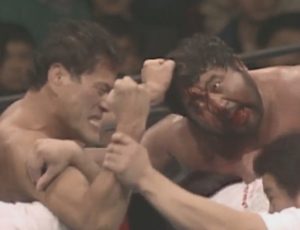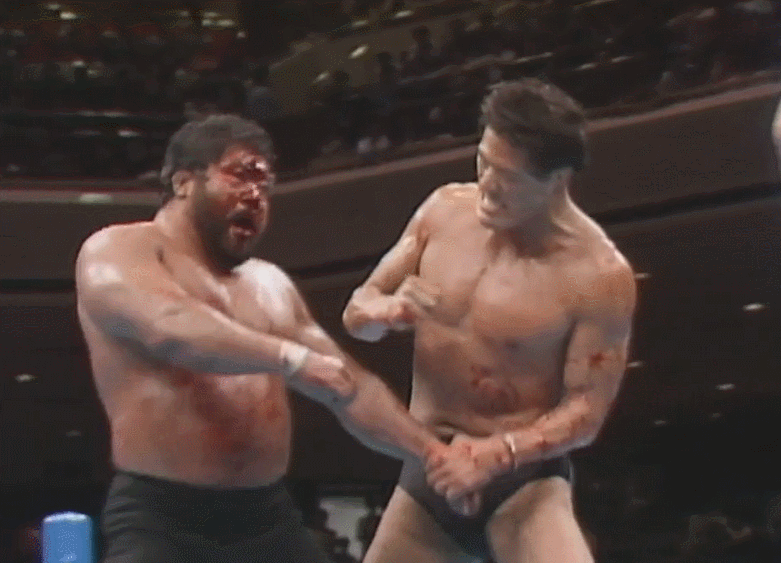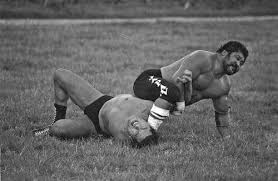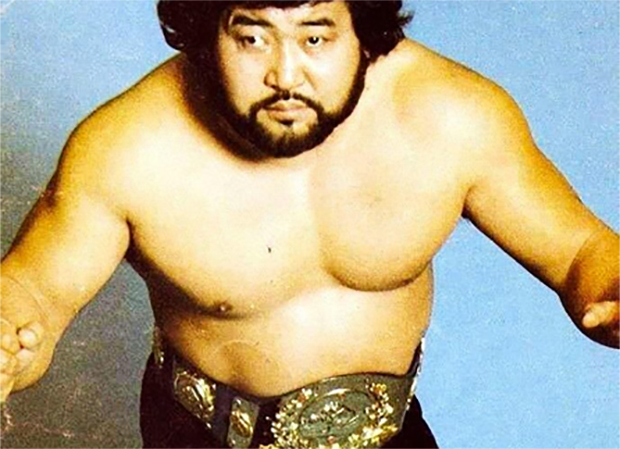In the annals of Japanese wrestling history two names dominated the 60’s into the 1990s – Giant Baba and Antonio Inoki, The men were both trained by the “Father of Puroresu” Rikidozan, debuting on the same card in September of 1960 for the JWA (Japan Pro Wrestling Alliance). Baba was positioned as the star between the two men, and despite being off and on again tag team partners, Inoki wanted a proper spotlight for himself.
Inoki first attempted to leave the JWA in the mid 60’s after Rikidozan was murdered in a nightclub. He was the main star for the newly formed “Tokyo Pro Wrestling”. Despite bringing in talent like Johnny Valentine for Inoki to face in highly pushed matches, business struggled for the start up league. Meanwhile, the JWA rediscovered the footing it had lost via the death of Rikidozan by building around Baba being protected as the top star. Inoki’s group eventually folded and he returned as a heavily pushed star, second only to Baba, within the JWA.
This is where things stood until December of 1971. Inoki and Baba lost their NWA International tag titles to the Funk Brothers. That would prove to be Inoki’s last match with the JWA as he was fired for attempting a hostile takeover of the company. Inoki formed New Japan Pro Wrestling to showcase himself. Shortly thereafter, the JWA got into a TV dispute, which ended up being the catalyst for Baba leaving the JWA. Baba then formed All-Japan Pro Wrestling. Inoki and Baba were rivals searching for the biggest spotlight once again.
Baba partnered with the NWA, giving him access to Jack Brisco, the Funks, Bruno Sammartino and many other major stars. Inoki lacked those connections and had to create his own roster. He brought in living legends such as Lou Thesz and Karl Gotch to put him over as a shooter, while also fighting in freak show matches with people like strongman “The Great Antonio”, martial artists, judo experts, and even Muhammad Ali.
The rival companies began poaching one another’s talent, with perhaps the most prominent early example being Billy Robinson. Robinson was already a legend in Japan from an earlier run, so his name value was high. Robinson fought Inoki to a sixty-minute draw in December of 1975, afterwards he and Inoki had a falling out over pay. Baba stepped in and paid Robinson the highest salary amount for any regular talent at that point in Japan. Baba then promptly booked himself to go over Robinson, proving to the fans that he was superior to Inoki.
The battle over talent, TV ratings and fan interest raged on through the 80’s. In Japan the TV season begins in April and October, so the promoters were always looking for something exciting to capture the fan’s imagination and eyes to their product. Inoki’s plan for 1987 revolved around a feud with himself and Masa Saito.
Saito had represented Japan in freestyle wrestling in the 1964 Olympics and then turned to pro wrestling. He became a star in America, being hand picked by Florida promoter Eddie Graham to beat NCAA star Jack Brisco for Florida’s top championship in 1970. The promotion played up the all-American star losing to a sneaky foreign heel for all it was worth. Saito spent the 70’s crossing North America wrestling coast to coast in the continental U.S. as well as Canada, winning titles all along the way. In 1981, Saito was brought into the WWF to partner with Mr. Fuji. The tandem won the WWF World tag titles twice as they feuded with Rick Martel and Tony Garea, as well as Jules and Jay Strongbow.
In 1983, Saito jumped to the AWA where he was immediately placed into a feud with Hulk Hogan. He would later take Jesse Ventura on as his frequent tag team partner, then moved on to Nick Bockwinkel when Ventura leapt to the WWF. Saito remained a top heel up until he was sent to prison in the summer of 1985 for his involvement in a brawl with the police in a small Wisconsin town. Saito’s subsequent release from prison two years later gave Inoki a fresh opponent to utilize.
The feud was built up over the course of many matches. On March 26th, 1987, Inoki and Saito were locked in battle. Saito procured a pair of handcuffs which he then used to ground into Inoki’s head, causing Inoki to become so enraged that he tore apart one of the turnbuckles in order to use it as a defensive weapon. Saito managed to ultimately down Inoki with more blows from the cuffs, and the match ended with other wrestlers pouring into the ring to break the fracas up.

A rematch on April 27th built on the chaos of the previous encounter. After combating for sometime, Inoki ordered the ring crew to tear down the ropes. This was clearly no longer a standard wrestling match. Inoki proceeded to beat Saito bloody. Saito’s protégé Hiroshi Hase produced a pair of handcuffs, leading to Saito and Inoki being bound by the wrist. Inoki went on to pound Saito into a bloody mess, with Hase finally ending the massacre by tossing in a towel.

Inoki added further salt to the wound in June when he bested Saito in the finals of a tournament to determine the first ever IWGP champion.
The final chapter of this feud would not come off until October. The rivals agreed to end their blood lust for one another by taking part in a match on Ganryujima Island, which was a small island with no inhabitants. The island enjoyed a historical importance in Japanese culture. In the year 1612 two famous swordsmen, Kojiro Sasaki and Musashi Miyamoto, faced off with one another in a battle on the island that was became so famous that it was still revered hundreds of years later.. Inoki sought to play off of that by placing himself and Saito into the roles of the famous warriors.
I first read of this match as a teenager. I was perusing old Apter magazines years after the encounter had originally went down. It was part of a monthly column where the writer supposedly flew around the world to report on wrestling first hand. In reality, the writer was probably one of many made up by Bill Apter for “editorial entertainment” purposes. Nonetheless, the description of the Inoki running out of the jungle “like a madman” assaulting Saito across the island terrain for two hours until the blood loss and physical toll proved to much for Saito to handle aroused my curiosity.

The match never left my mind, and a decade or so later my finances and modern technology came together and I was able to acquire a DVD of this spectacle. The match itself plays out better in highlights and snippets than attempting to watch it in longform. Saito screams for “INOKI!” to emerge as helicopters whirl above his head. There is a ring set up, but it is only prefunctionatory as the men come and go as they please. Given that the match ultimately goes for a hair over two hours, the action does leave something to desire as there are many submission holds that tend to go on and on. Dusk falls upon the men, leading their handlers on the island setting off large fires to light the action. The men eventually incorporated the flames into the match as Inoki tossed Saito into the blaze, which reportedly nearly gave Saito a very real injury to his eyes. Inoki would suffer a dislocated shoulder while absorbing Saito’s offense along the way. The modern day samurais both wound up pouring out blood and sweat as they struggled for supremacy. Inoki ultimately locked Saito into a sleeper hold, which ended things by “technical knock out”. Even in victory, Inoki sold the long struggle by collapsing as he stumbled back to the tent that served as his makeshift locker room.
Given the history of the island, the match needed something to provide an epic feeling to it. The two-hour length provided a good base to construct a narrative out of as the promotion built up the unique final encounter of two legendary combatants.
The match is generally not viewed well amongst the modern era of keyboard pundits. I suppose one could liken this to Royce Gracie’s fight with Kazushi Sakuraba in the Pride 2000 Grand Prix MMA tournament. Sakuraba was representing professional wrestling, and in particular his mentor Nobuhiko Takada. Takada had challenged and lost to Royce’s brother Rickson twice, then lost to Royce himself. It was up to Sakuraba to restore the dignity of Takada. The fight was contested under special rules where the ref could not stop the action and there would be no time limits. The battle ultimately went 90 minutes. A novice watching the struggle at home may be bored without understanding the whole backstory, but the drama and theatrics play out in an entertaining manner if your invested in the battle. Sakuraba often toyed with Royce as the match progressed, yanking on his gi at times, and making faces to show the crowd he is in no pain while Royce attempted to lock on submissions. If you were an MMA fan waiting to see Royce finally get his comeuppance after his dominant UFC run, this is a pleasure to watch. Sakuraba ultimately won the contest by injuring Royce’s legs enough that his family mercifully ended things for him.
Inoki would go back to the island gimmick four years later as New Japan booked Hiroshi Hase to face Tiger Jeet Singh on the archipelago. The match lacked the length of the Inoki/Saito encounter, but was very gory as both men gushed plentiful amounts of blood before Hase proved victorious. Mr. Saito played a role in the match as he served as the “ref” who stopped the bout. Inoki was part of the build up as well, as Inoki was scheduled to face Singh at an upcoming Tokyo Dome show, but Hase demanded a chance to face Inoki instead. Hase was told by Inoki that he had to eliminate Singh in order to be awarded a match with Inoki.


